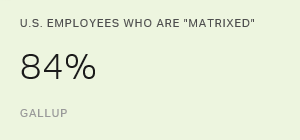Story Highlights
- Many companies are restructuring to build networks of teams
- Matrixed employees can be more collaborative but may lack role clarity
- Managers need to clarify expectations and keep teams small
Teams are not new to organizations. But the way companies are using them is changing.
A new team-centric organizational structure is surging among businesses and governments around the world, according to a recent Economist article.
To remain flexible in today's fast-paced, digital marketplace, leaders are saying goodbye to traditional hierarchical models and are restructuring to develop dynamic networks of highly empowered, interdisciplinary teams. In a study of more than 7,000 executives in 130 countries, Deloitte found that more than 80% of respondents surveyed say their companies are either currently restructuring or have recently finished the process. According to The Economist, teams have become "the basic building-blocks" of organizations.
Under this model, teams are garnering greater power, autonomy and authority. They spend their time collaborating and reporting to each other, not to higher-level leaders, as they establish their goals and make strategic decisions with the company's overall business objectives in mind.
Rather than organizing teams by business function, leaders are structuring them based on a shared mission, product, market or customer. As companies work to become more nimble, they are emphasizing cross-disciplinary functionality and enabling workers to move from team to team to meet project needs.
Gallup research suggests that 84% of U.S. employees are "matrixed" to some extent -- that is, they may work on multiple teams every day, reporting to the same or different managers. These matrixed employees can be divided into three groups: 49% serve on multiple teams some workdays (categorized as slightly matrixed), while 18% serve on multiple teams every workday with different people, though mostly reporting to the same manager (matrixed). The remaining 17% work on multiple teams every day with different people and different managers (supermatrixed).

Is More Teamwork Always Better?
The saying goes: Teamwork can make the dream work. But is more teamwork always better? Not necessarily, says Leigh Thompson of the Kellogg School of Management in Illinois. According to The Economist, she cautions that teams "are not always the answer -- teams may provide insight, creativity and knowledge in a way that a person working independently cannot; but teamwork may also lead to confusion, delay and poor decision-making."
The late Richard Hackman of Harvard University shared similar doubts about the power of teams, The Economist notes. Teams can produce magic, he argued, but it's not guaranteed. He also asserted that high performers can be undervalued while low performers aren't pushed to improve. These negatives can entirely undo the collaborative advantages teams represent.
Hackman also found that competition among teams can hinder progress -- undermining even the most capable, cohesive teams. And in a study of 120 teams of senior executives, Hackman discovered that less than 10% of supposed team members agreed on who their teammates were. This finding raises the question: If teammates can't agree on whom they're collaborating with, how can they align on purpose and expectations?
Gallup research suggests that as organizations become more matrixed, collaboration may increase, but employees can become less clear about their roles and what is expected of them. This lack of clarity is no small problem because role clarity and accountability are among the most important drivers of employee engagement and overall organizational health.
Two Ways to Build Clarity and Accountability
To ensure that teams achieve their goals, leaders need to provide role clarity and accountability through consistent, ongoing communication. Here are two approaches leaders can take to build a more collaborative workplace:
Clarify expectations. Gallup research indicates that an engaged, high-performing workforce is founded on clarity of expectations. Clear and accountable roles promote organizational health and performance.
Unfortunately, a minority of supermatrixed employees strongly agree with the statement, "I know what is expected of me at work," compared with 60% of non-matrixed employees. Workers in the three matrixed groups also are more likely than non-matrixed employees to say they need clear direction from project leaders and communication between their managers and project leaders to prioritize their work.
The matrix structure is notorious for frequently obscuring lines of accountability. One common complaint is that matrixed organizations lack clarity of responsibility and expectations, and it can be difficult to understand who reports to whom.
Leaders need to address the problem of role ambiguity that pervades matrixed companies, helping employees by continually setting clear expectations that are in step with company objectives. This clarity should involve frequent conversations between managers and workers about the specific role each person plays in advancing organizational goals. It's on leaders' and managers' shoulders to ensure that employees understand whom they answer to and the duties for which they are responsible.
Keep teams small. Teams are garnering greater power, autonomy and authority. Often, smaller teams can be more effective. The Economist article states that companies "need to keep teams small and focused: Giving in to pressure to be more 'inclusive' is a guarantee of dysfunction." Echoing this sentiment, Amazon CEO Jeff Bezos says, "If I see more than two pizzas for lunch, the team is too big."
Gallup finds that employees in the three matrixed categories are more likely than non-matrixed employees to say they spend their days responding to coworkers' requests and attending internal meetings, which can "slow decision-making, blur lines of communication, stifle productivity and hinder organizational responsiveness and agility." Though some managers have proven masterful at engaging larger teams, on average, employees tend to be more engaged when they are part of teams with fewer than 10 members. This means that when feasible, leaders should attempt to keep teams small.
Navigating the team-focused trend will undoubtedly pose challenges for leaders. Just 12% of executives surveyed report they understand how employees work together in networks, and only 21% are confident in their ability to develop cross-functioning teams, according to Deloitte research.
But mastering the team dynamic will pay off -- and much of this responsibility falls on the manager. Gallup research shows that 70% of the variance in employee engagement scores is attributable to managers and how effectively they guide their teams. Given the relationship between worker engagement and crucial business outcomes -- such as productivity, profitability and customer perceptions of service quality -- managers and their teams hold the keys to organizational health.
As teams evolve, it's important for managers and leaders to ensure that expectations are crystal clear, accountability is commonplace and team size doesn't undermine productivity and engagement.
